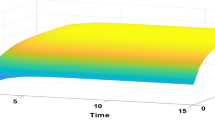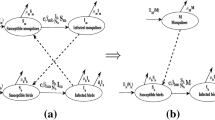Abstract
We derive appropriate mathematical models to assess the effectiveness of culling as a tool to eradicate vector-borne diseases. The model, focused on the culling strategies determined by the stages during the development of the vector, becomes either a system of autonomous delay differential equations with impulses (in the case where the adult vector is subject to culling) or a system of nonautonomous delay differential equations where the time-varying coefficients are determined by the culling times and rates (in the case where only the immature vector is subject to culling). Sufficient conditions are derived to ensure eradication of the disease, and simulations are provided to compare the effectiveness of larvicides and insecticide sprays for the control of West Nile virus. We show that eradication of vector-borne diseases is possible by culling the vector at either the immature or the mature phase, even though the size of the vector is oscillating and above a certain level.
Similar content being viewed by others
References
Bowman C., Gumel A.B., van den Driessche P., Wu J., Zhu H. (2005) A mathematical model for assessing control strategies against west nile virus. Bull. Math. Biol., 67, 1107–1133
Centers for Disease Control and Prevention. Outbreak of West Nile-like viral encephalitis- New York, 1999. MMWR Morb. Mortal. Wkly. Rep. 48, 845–849 (1999)
Hayes C.G. (2001) West Nile virus: Uganda, 1937, to New York City, 1999. Ann. N. Y. Acad. Sci. 951, 25–37
Hubálek Z., Halouzka J. (1999) West Nile fever: a reemerging mosquito-borne viral disease in Europe. Emerg. Infect. Dis. 5, 643–650
Kuang Y. Delay differential equations with applications in population dynamics. In: Mathematics in Science and Engineering, vol 191. Academic, Boston (1993)
Lord C.C., Day J.F. (2001) Simulation studies of St. Louis encephalitis and West Nile virues: the impact of bird mortality. Vector Borne Zoonotic Dis. 1(4): 317–329
Nash D., Mostashari F., Fine A., et al. (2001) The outbreak of West Nile virus infection in the New York City area in 1999. N. Eng. J. Med. 344, 1807–1814
Petersen L.R., Anthony A.M. (2002) West Nile virus: a primer for the clinician. Ann. Intern. Med. 137, 173–179
Simons R.R.L., Gourley S.A. (2006) Extinction criteria in stage-structured population models with impulsive culling. SIAM. J. Appl. Math. 66, 1853–1870
Smith H.L. (1995) Monotone dynamical systems. An introduction to the theory of competitive and cooperative systems. American Mathematical Society, Providence
Smithburn K.C., Hughes T.P., Burke A.W., Paul J.H. (1940) A neurotropic virus isolated from the blood of a native of Uganda. Am. J. Trop. Med. 20, 471–492
Wonham M.J., de-Camino-Beck T., Lewis M. (2004) An epidemiological model for West Nile virus: invasion analysis and control applications. Proc. R. Soc. Lond. Ser. B 271, 501–507
Author information
Authors and Affiliations
Corresponding author
Rights and permissions
About this article
Cite this article
Gourley, S.A., Liu, R. & Wu, J. Eradicating vector-borne diseases via age-structured culling. J. Math. Biol. 54, 309–335 (2007). https://doi.org/10.1007/s00285-006-0050-x
Received:
Published:
Issue Date:
DOI: https://doi.org/10.1007/s00285-006-0050-x




